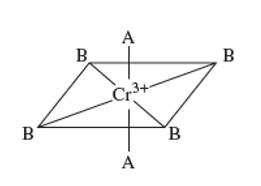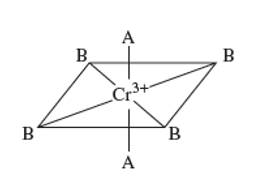
Concept explainers
(a)
Interpretation: The appropriate crystal field diagram of the given complex ion needs to be determined, if ligand A lie on the z axis:

Concept Introduction:
Crystal field theory is the theory given to explain the bonding in the coordination complexes. As ligand approaches towards the metal ion, the d-orbital of metal ion divide according to the energy of metal ion. On the basis of energy and degeneracy, the d-orbital can be classified as
In octahedral complex, the
(b)
Interpretation: The approximate molecular orbital diagram for the given complex ion with assumption of only sigma bonding needs to be determined.

Concept Introduction:
Crystal field theory is the theory given to explain the bonding in the coordination complexes. As ligand approaches towards the metal ion, the d-orbital of metal ion divide according to the energy of metal ion. On the basis of energy and degeneracy, the d-orbital can be classified as
In octahedral complex, the
(c)
Interpretation: The difference in molecular orbital diagram and crystal field diagram for the given complex needs to be determined with respect to d-orbital. Also, the assumption needs to be reconstructed to achieve agreement between two.


Concept Introduction:
Crystal field theory is the theory given to explain the bonding in the coordination complexes. As ligand approaches towards the metal ion, the d-orbital of metal ion divide according to the energy of metal ion. On the basis of energy and degeneracy, the d-orbital can be classified as
In octahedral complex, the
Want to see the full answer?
Check out a sample textbook solution
Chapter 19 Solutions
EBK CHEMICAL PRINCIPLES
- A mixture of C7H12O2, C9H9OCl, biphenyl and acetone was put together in a gas chromatography tube. Please decide from the GC resutls which correspond to the peak for C7,C9 and biphenyl and explain the reasoning based on GC results. Eliminate unnecessary peaks from Gas Chromatography results.arrow_forwardIs the molecule chiral, meso, or achiral? CI .CH3 H₂C CIarrow_forwardPLEASE HELP ! URGENT!arrow_forward
- Identify priority of the substituents: CH3arrow_forwardHow many chiral carbons are in the molecule? OH F CI Brarrow_forwardA mixture of three compounds Phen-A, Acet-B and Rin-C was analyzed using TLC with 1:9 ethanol: hexane as the mobile phase. The TLC plate showed three spots of R, 0.1 and 0.2 and 0.3. Which of the three compounds (Phen-A; Acet-B or Rin-C) would have the highest (Blank 1), middle (Blank 2) and lowest (Blank 3) spot respectively? 0 CH: 0 CH, 0 H.C OH H.CN OH Acet-B Rin-C phen-A A A <arrow_forward
 Principles of Modern ChemistryChemistryISBN:9781305079113Author:David W. Oxtoby, H. Pat Gillis, Laurie J. ButlerPublisher:Cengage Learning
Principles of Modern ChemistryChemistryISBN:9781305079113Author:David W. Oxtoby, H. Pat Gillis, Laurie J. ButlerPublisher:Cengage Learning Chemistry: Principles and PracticeChemistryISBN:9780534420123Author:Daniel L. Reger, Scott R. Goode, David W. Ball, Edward MercerPublisher:Cengage Learning
Chemistry: Principles and PracticeChemistryISBN:9780534420123Author:Daniel L. Reger, Scott R. Goode, David W. Ball, Edward MercerPublisher:Cengage Learning Chemistry: The Molecular ScienceChemistryISBN:9781285199047Author:John W. Moore, Conrad L. StanitskiPublisher:Cengage Learning
Chemistry: The Molecular ScienceChemistryISBN:9781285199047Author:John W. Moore, Conrad L. StanitskiPublisher:Cengage Learning ChemistryChemistryISBN:9781305957404Author:Steven S. Zumdahl, Susan A. Zumdahl, Donald J. DeCostePublisher:Cengage Learning
ChemistryChemistryISBN:9781305957404Author:Steven S. Zumdahl, Susan A. Zumdahl, Donald J. DeCostePublisher:Cengage Learning Chemistry: An Atoms First ApproachChemistryISBN:9781305079243Author:Steven S. Zumdahl, Susan A. ZumdahlPublisher:Cengage Learning
Chemistry: An Atoms First ApproachChemistryISBN:9781305079243Author:Steven S. Zumdahl, Susan A. ZumdahlPublisher:Cengage Learning





